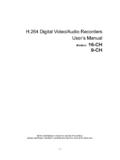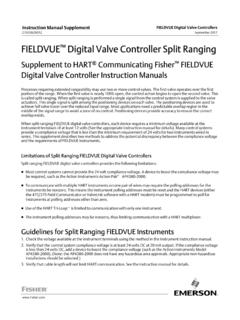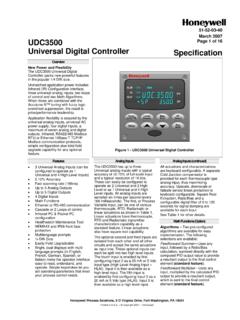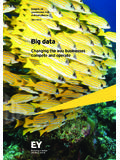Transcription of SECTION 6 DIGITAL FILTERS - Mixed-signal and …
1 DIGITAL 6 DIGITAL FILTERS Finite Impulse Response (FIR) FILTERS Infinite Impulse Response (IIR) FILTERS Multirate FILTERS Adaptive FiltersDIGITAL 6 DIGITAL FILTERSWalt KesterINTRODUCTIOND igital filtering is one of the most powerful tools of DSP. Apart from the obviousadvantages of virtually eliminating errors in the filter associated with passivecomponent fluctuations over time and temperature, op amp drift (active FILTERS ), etc., DIGITAL FILTERS are capable of performance specifications that would, at best, beextremely difficult, if not impossible, to achieve with an analog implementation. Inaddition, the characteristics of a DIGITAL filter can be easily changed under softwarecontrol. Therefore, they are widely used in adaptive filtering applications incommunications such as echo cancellation in modems, noise cancellation, andspeech actual procedure for designing DIGITAL FILTERS has the same fundamentalelements as that for analog FILTERS .
2 First, the desired filter responses arecharacterized, and the filter parameters are then calculated. Characteristics such asamplitude and phase response are derived in the same way. The key differencebetween analog and DIGITAL FILTERS is that instead of calculating resistor, capacitor,and inductor values for an analog filter, coefficient values are calculated for a digitalfilter. So for the DIGITAL filter, numbers replace the physical resistor and capacitorcomponents of the analog filter. These numbers reside in a memory as filtercoefficients and are used with the sampled data values from the ADC to perform thefilter real-time DIGITAL filter, because it is a discrete time function, works withdigitized data as opposed to a continuous waveform, and a new data point isacquired each sampling period.
3 Because of this discrete nature, data samples arereferenced as numbers such as sample 1, sample 2, sample 3, etc. Figure showsa low frequency signal containing higher frequency noise which must be filtered waveform must be digitized with an ADC to produce samples x(n). These datavalues are fed to the DIGITAL filter, which in this case is a lowpass filter. The outputdata samples, y(n), are used to reconstruct an analog waveform using a low FILTERS , however, are not the answer to all signal processing filteringrequirements. In order to maintain real-time operation, the DSP processor must beable to execute all the steps in the filter routine within one sampling clock period,1/fs. A fast general purpose fixed-point DSP such as the ADSP-2189M at 75 MIPScan execute a complete filter tap multiply-accumulate instruction in TheADSP-2189M requires N+5 instructions for an N-tap filter.
4 For a 100-tap filter, thetotal execution time is approximately s. This corresponds to a maximumpossible sampling frequency of 714kHz, thereby limiting the upper signalbandwidth to a few hundred , it is possible to replace a general purpose DSP chip and design specialhardware DIGITAL FILTERS which will operate at video-speed sampling rates. In othercases, the speed limitations can be overcome by first storing the high speed ADCdata in a buffer memory. The buffer memory is then read at a rate which iscompatible with the speed of the DSP-based DIGITAL filter. In this manner, pseudo-realtime operation can be maintained as in a radar system, where signal processingis typically done on bursts of data collected after each transmitted option is to use a third-party dedicated DSP filter engine like the SystolixPulseDSP filter core.
5 The AD7725 16-bit sigma-delta ADC has an on-chipPulseDSP filter which can do 125 million multiply-accumulates per in highly oversampled sampled data systems, an analog antialiasing filter isstill required ahead of the ADC and a reconstruction (anti-imaging) filter after theDAC. Finally, as signal frequencies increase sufficiently, they surpass thecapabilities of available ADCs, and DIGITAL filtering then becomes impossible. Activeanalog filtering is not possible at extremely high frequencies because of op ampbandwidth and distortion limitations, and filtering requirements must then be metusing purely passive components. The primary focus of the following discussionswill be on FILTERS which can run in real-time under DSP program an example, consider the comparison between an analog and a DIGITAL filtershown in Figure The cutoff frequency of the both FILTERS is 1kHz.
6 The analogfilter is realized as a 6-pole Chebyshev Type 1 filter (ripple in passband, no ripple instopband). In practice, this filter would probably be realized using three 2-polestages, each of which requires an op amp, and several resistors and capacitors. The6-pole design is certainly not trivial, and maintaining the ripple specificationrequires accurate component selection and FILTERINGADCDIGITALLOWPASSFILTERANALOGAN TIALIASINGFILTERDACttH(f)ffsfsANALOGANTI -IMAGINGFILTERx(n)y(n) DIGITAL the other hand, the DIGITAL FIR filter shown has only passband ripple,linear phase, and a much sharper roll off. In fact, it could not be realized usinganalog techniques! In a practical application, there are many other factors toconsider when evaluating analog versus DIGITAL FILTERS .
7 Most modern signalprocessing systems use a combination of analog and DIGITAL techniques in order toaccomplish the desired function and take advantage of the best of both the analogand the DIGITAL are many applications where DIGITAL FILTERS must operate in real-time. Thisplaces specific requirements on the DSP depending upon the sampling frequencyand the filter complexity. The key point is that the DSP must finish allcomputations during the sampling period so it will be ready to process the next datasample. Assume that the analog signal bandwidth to be processed is fa. Thisrequires the ADC sampling frequency fs to be at least 2fa. The sampling period is1/fs. All DSP filter computations (including overhead) must be completed duringthis interval. The computation time depends on the number of taps in the filter andthe speed and efficiency of the DSP.
8 Each tap on the filter requires onemultiplication and one addition (multiply-accumulate). DSPs are generallyoptimized to perform fast multiply-accumulates, and many DSPs have additionalfeatures such as circular buffering and zero-overhead looping minimize the overhead instructions that otherwise would be VERSUS ANALOG FILTERINGDIGITAL FILTERSHigh AccuracyLinear Phase (FIR FILTERS )No Drift Due to ComponentVariationsFlexible, Adaptive Filtering PossibleEasy to Simulate and DesignComputation Must be Completed inSampling Period - Limits Real TimeOperationRequires High Performance ADC,DAC & DSPANALOG FILTERSLess Accuracy - Component TolerancesNon-Linear PhaseDrift Due to ComponentVariationsAdaptive FILTERS DifficultDifficult to Simulate and DesignAnalog FILTERS Required atHigh Frequencies and forAnti-Aliasing FiltersNo ADC, DAC, or DSP RequiredDIGITAL VERSUS DIGITAL FILTERFREQUENCY RESPONSE COMPARISON0 40 20 60 80 1000 40 20 60 80 100012345012345 ANALOG FILTERC hebyshev Type 1 6 Pole, RippleDIGITAL FILTERFIR, 129-Tap, Ripple,Linear Phase, fs = 10kSPSdBdBFREQUENCY (kHz)FREQUENCY (kHz)
9 PROCESSING REQUIREMENTSFOR REAL TIME DIGITAL FILTERING Signal Bandwidth = fa Sampling Frequency fs > 2fa Sampling Period = 1 / fs Filter Computational Time + Overhead < Sampling Period Depends on Number of Taps Speed of DSP Multiplication-Accumulates (MACs) Efficiency of DSP Circular Buffering Zero Overhead Looping IMPULSE RESPONSE (FIR) FILTERST here are two fundamental types of DIGITAL FILTERS : finite impulse response (FIR) andinfinite impulse response (IIR). As the terminology suggests, these classificationsrefer to the filter s impulse response. By varying the weight of the coefficients andthe number of filter taps, virtually any frequency response characteristic can berealized with an FIR filter. As has been shown, FIR FILTERS can achieve performancelevels which are not possible with analog filter techniques (such as perfect linearphase response).
10 However, high performance FIR FILTERS generally require a largenumber of multiply-accumulates and therefore require fast and efficient DSPs. Onthe other hand, IIR FILTERS tend to mimic the performance of traditional analogfilters and make use of feedback. Therefore their impulse response extends over aninfinite period of time. Because of feedback, IIR FILTERS can be implemented withfewer coefficients than for an FIR filter. Lattice FILTERS are simply another way toimplement either FIR or IIR FILTERS and are often used in speech processingapplications. Finally, DIGITAL FILTERS lend themselves to adaptive filteringapplications simply because of the speed and ease with which the filtercharacteristics can be changed by varying the filter most elementary form of an FIR filter is a moving average filter as shown inFigure Moving average FILTERS are popular for smoothing data, such as in theanalysis of stock prices, etc.















